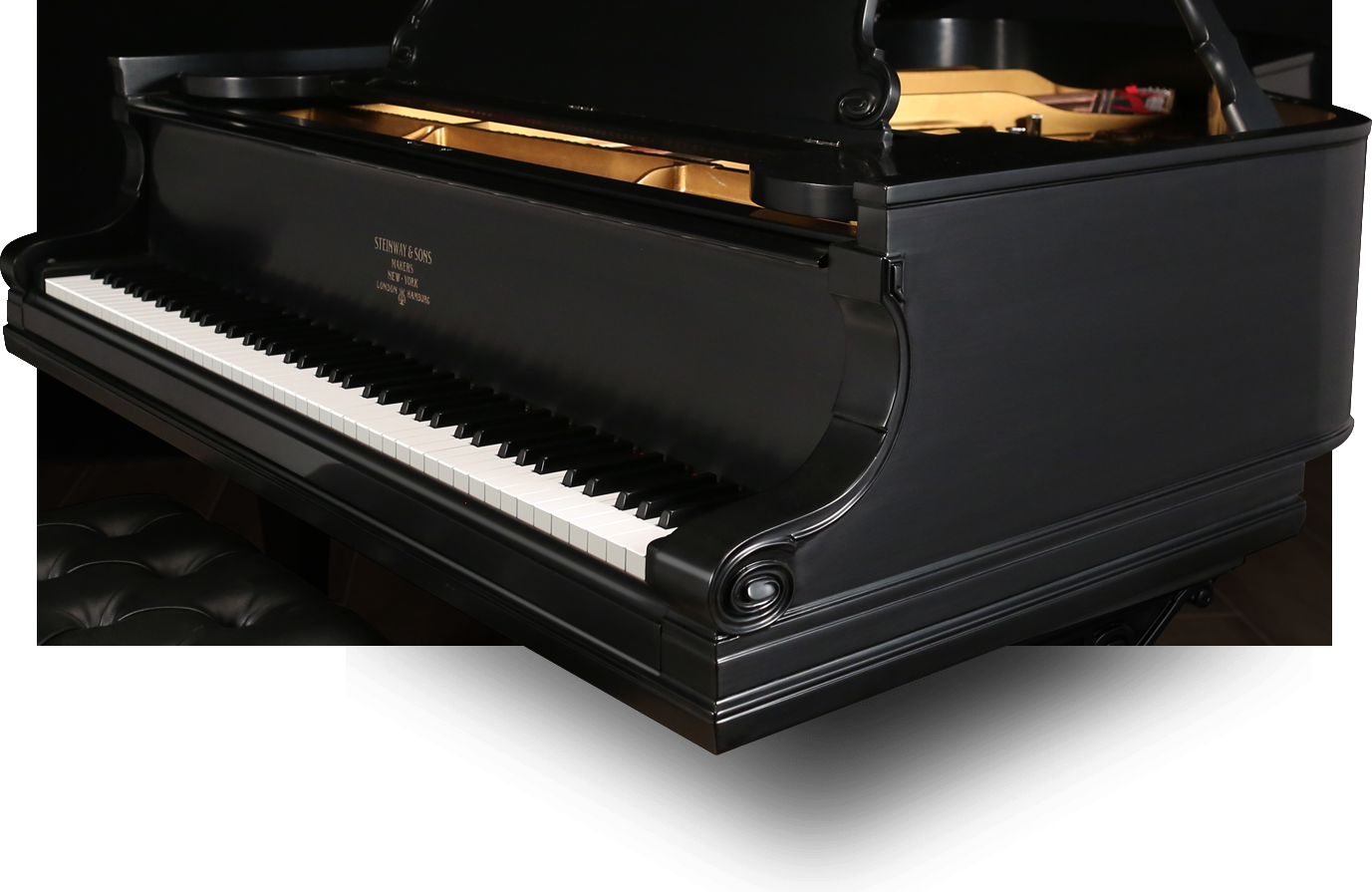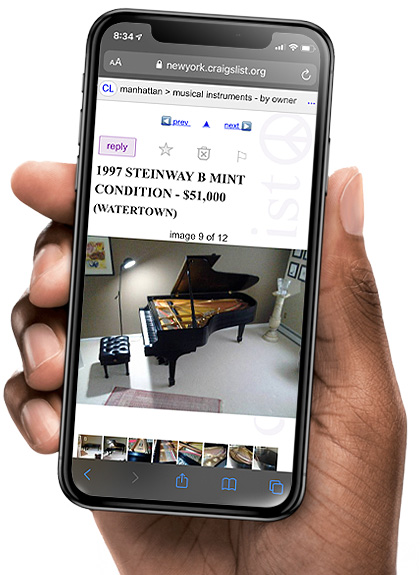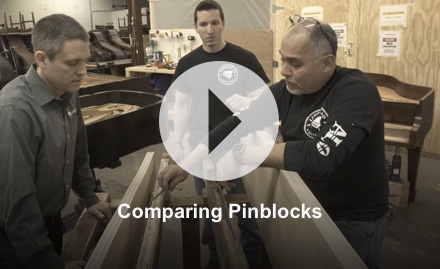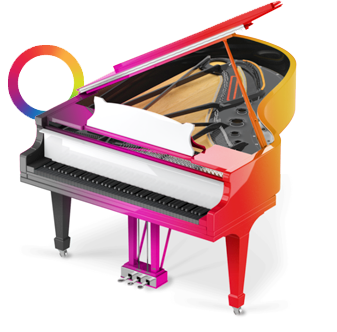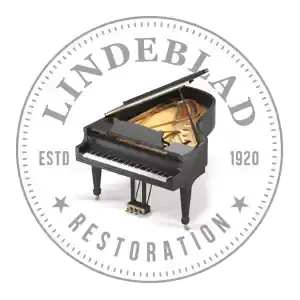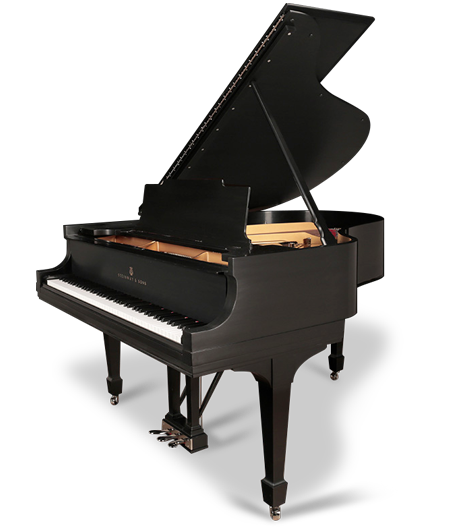Selecting
A Steinway
Buying New, Used,
or Restored?
When considering the purchase of a Steinway, there are three main types you can choose from. We've simplified your search by breaking each option down into simple pros and cons.
Pros
Cons
New
Steinway
One of the great benefits of buying a new Steinway is that because it's all-new, there isn't much homework involved. You know what you're getting and you can trust the quality.
The only downside is price. A new Steinway grand ranges from $75,500 on the low end and up to $585,000 for certain concert grands (as of 2021).
Used
Steinway
Used Steinways can be between 50% and 70% cheaper than a new Steinway. This option is much more popular considering their lower cost.
The condition and quality of a used Steinway is uncertain. You could purchase the piano only to later discover that it needs tens of thousands of dollars in repairs.
Also, the typical lifespan of a piano ranges between 65 and 75 years. If you buy a Steinway that's 30 to 40 years old, you could be investing a large amount of money only to have half its life used up.
Restored
Steinway
If you can find a company that uses genuine Steinway parts, installed to the right specifications by experienced Steinway craftsmen, you could essentially get a brand new Steinway Grand for the same low cost of a used one.
Pro Tip
Look for a restorer that specializes in Steinways and restores hundreds of them each year.
Not all restoration companies are equal. The range in quality between an experienced Steinway restoration company and a small rebuilder is vast. Since it's an unregulated industry, anyone in their garage can make a website and say they're a piano restorer. It's essential you know who you are working with.
5 Things You
Need to Know
Do you own a Steinway and are wondering about its age? Check out How Old Is My Steinway for helpful tips and tricks.
Buying Privately or
From a Dealer
Which Model/Size
Fits Best
As you continue to research your options, it can be difficult to visualize the difference between Steinway Models. To assist with your research, we will send a Steinway Sizing Template to your home free of charge. This one's on us.
Additionally, if you send us the dimensions of your room, our interior designer can sketch some samples to help you assess your best options.
Yes, send me a free
Sizing Template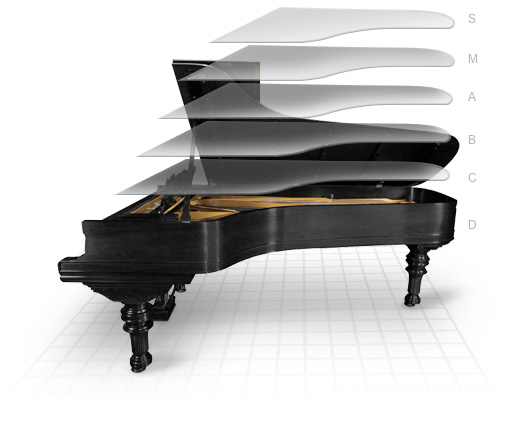
Question Checklist
When reaching out to dealers and private sellers, it's important to know the right questions to ask. Use this complete checklist to guide your research and help you avoid common purchasing mistakes.
Yes, I would like to use my free
Checklist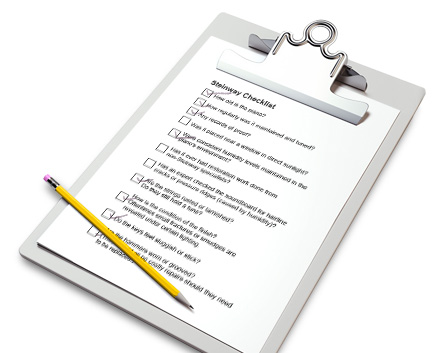
What Makes Up
A Steinway
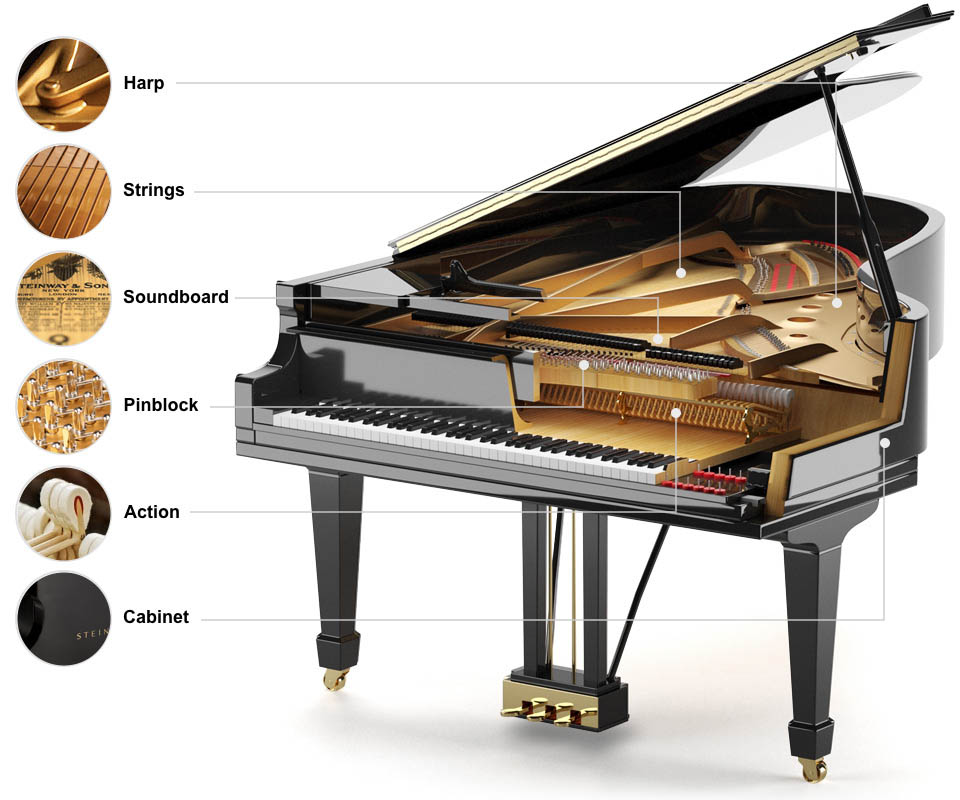
The Soundboard
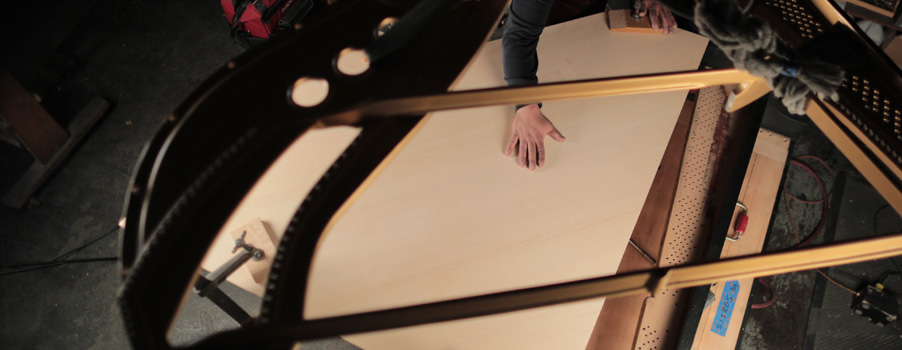
The soundboard is the heart and soul of every Steinway piano. It is responsible for magnifying the piano's sound as the hammers strike the strings. A Steinway diaphragmatic design – where the soundboard tapers several millimeters from the crown to the edge of the inner rim – and an exact fit inside the cabinet's rim are the recipe for resonance and projection.
A true Steinway soundboard is crafted from the choicest Alaskian Sitka Spruce. To ensure pure authenticity, we select ours from the same lumber yard as Steinway & Sons. Galo Torres (fromer Steinway soundboard craftsman of 30 years), then hand-crafts our Steinway soundboards to original specifications.
The Harp or Plate
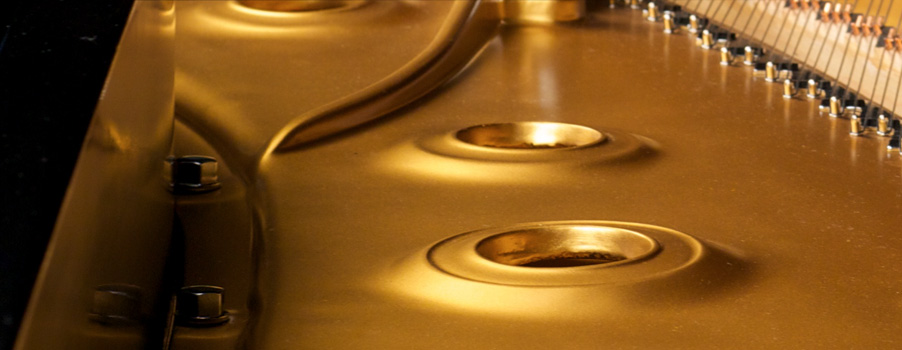
Accounting for half of a piano's weight, the cast-iron harp combines immense weight with an elegant aesthetic designed to bear 40,000 lbs. of string tension. Aside from the cabinet, the harp is the only other part of a vintage piano that is always reused in restoration. When we restore a Steinway harp, the original is sanded down and then re-bronzed with a new shiny finish.
Pro Tip
Make sure to check for hairline fractures when looking to purchase used. If a Steinway's harp is cracked, the piano is nearly worthless and cannot be repaired.
The Pinblock
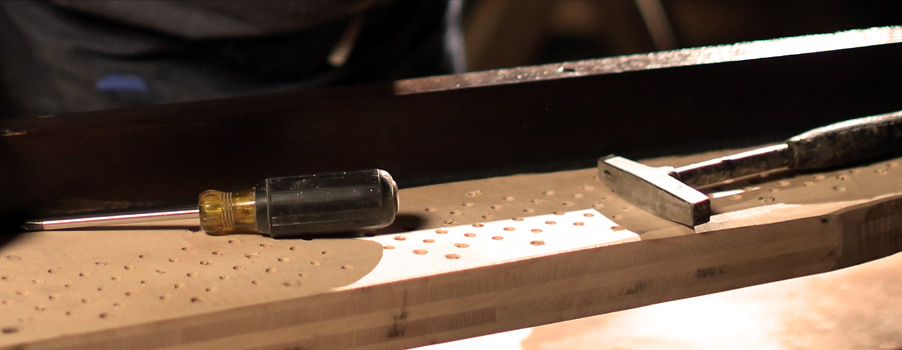
Carefully drilled with more than 200 holes, the pinblock's job is to tightly grip the tuning pins. It can be located underneath the harp and is responsible for maintaining a piano's tune. To ensure the tuning pins don't budge, pinblocks are made of 5 to 7 layers of kilned hard rock maple, and fastened onto the resting plank at a 7-degree angle.
Both Steinway and Lindeblad pinblocks are made from quarter-sawn hard rock maple. A quality pinblock comes not only from the wood that's used, but also from the craftsmanship involved when the pinblock is glued and doweled into the cabinet. This last step is often where many restoration teams go wrong.
The Strings
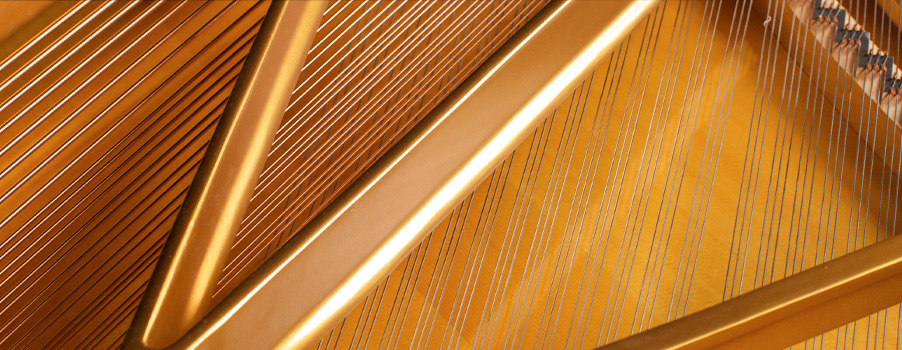
The most recognizable feature under a piano's lid is the strings. Over 200 strings are kept in A440 pitch by German made Diamond tuning pins, which are anchored into the pinblock. All of our strings are made from the finest Swedish steel.
We purchase our strings and tuning pins from the same supplier that Steinway uses for their new pianos.
The Action
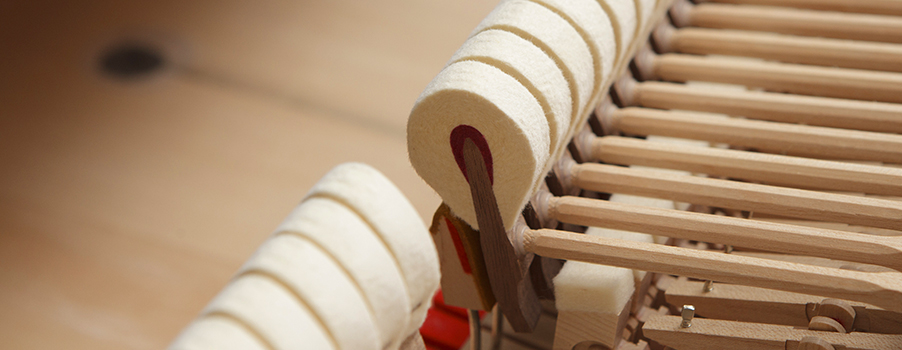
Often referred to as the "keybed" or "action stack," the action transfers the momentum of a musician's keystrokes to the strings. Actions give the desired volume, tonal effect, and repetition to each note. The action consists of wippens, shanks, hammers, and flanges.
We use Steinway action parts for every restoration, whether it's a New York Steinway action or a Hamburg Steinway action (made by Renner, a company Steinway owns*).
Action Regulation
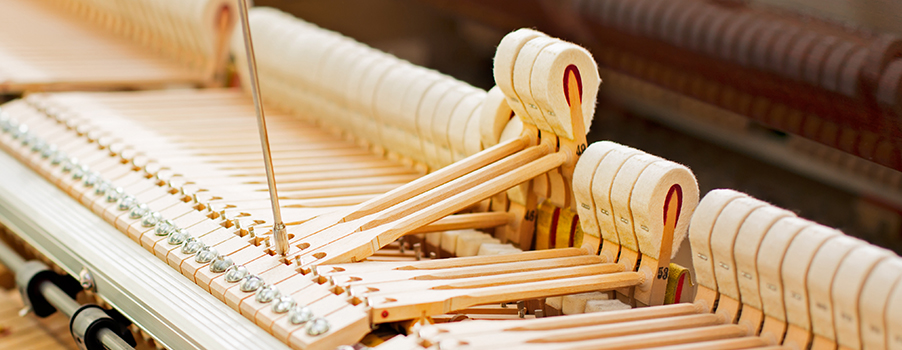
Grand pianos have over 10,000 moving parts. Many careful calibrations to these parts keep pianos playing beautifully. A single key's performance requires over 12 adjustments. Additionally, each hammer is voiced to match a musician's desired brilliance and resonance. Restoring a piano to its fullest potential requires a highly trained ear, an exact feel, and an intuition that only comes with generations of experience.
The Cabinet and Finish
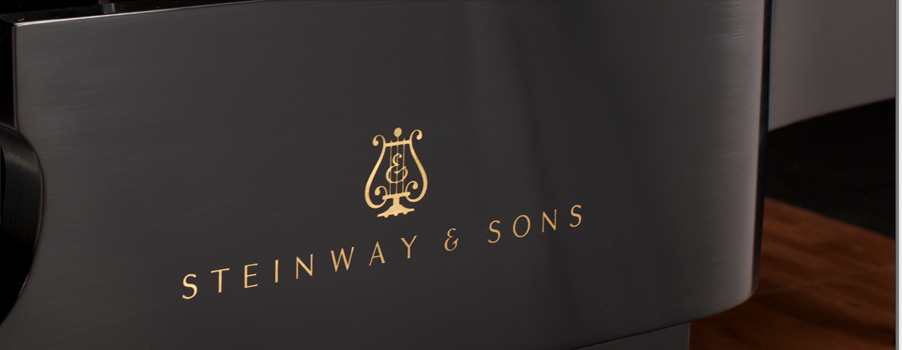
Cabinets are constructed by gluing together many thin pieces of hard rock maple and then covered with a layer of veneer. Popular veneer choices include: African Mahogany, Maple, Walnut, Circassian Walnut, and Rosewood. A cabinet's color is the most noticeable feature of a piano. Each cabinet is hand-rubbed with a colored stain to bring out the patterning of the wood's grain. Polish (satin or high gloss) and texture (open pore or closed pore) also add a unique dimension to each piano's finish. Unlike Steinway and many other restoration companies, Lindeblad allows customers to customize the finish of their Steinway. The options are unlimited since clients can choose any range of color, finish (satin vs high-gloss), veneer type, etc.
Myths and
Misconceptions
"If It Doesn't Have 12,116 Genuine Steinway Parts, It Isn't a Steinway"
While compelling, this statement by Steinway should not be blindly accepted. If their claim is correct, buyers will believe they can only purchase a genuine Steinway piano from Steinway & Sons and from no other seller. However, if their claim is not true, a world of options opens up for the buyer (since over 600,000 Steinways have been made) that are simultaneously cost-effective without reducing the quality and authenticity of the instrument.
In this section, we break down what makes a Steinway genuine, and why Steinway's claim is not what it seems to be.
There are three criteria that make a Steinway piano authentic:
- The craftsmanship required to install parts to Steinway standard
- The precise dimensions of those parts
- The quality of the parts used

With these criteria in mind, the question remains–does every single part need to come directly from Steinway for a piano to be considered a genuine Steinway?
The truth is that even parts in new Steinway pianos are not all made by Steinway. For example, Steinway doesn't make their own strings or tuning pins–instead, they buy them from independent suppliers.
Since Steinway's parts are not all manufactured in-house, it is clear that a Steinway is not made genuine by where the parts come from, but by the part dimensions, the materials used, and the craftsmen installing those parts to Steinway standards. Lindeblad uses the same Steinway parts or parts from their suppliers for most aspects of restoration, the main exceptions to this are the soundboard and pinblock.
In the next few sections, you'll read more about how these two major parts of a Steinway piano–the soundboard and the pinblock–are crafted in our facilities with the exact specifications and materials Steinway uses, by two craftsmen who have a combined 35 years of experience working at Steinway's factory.
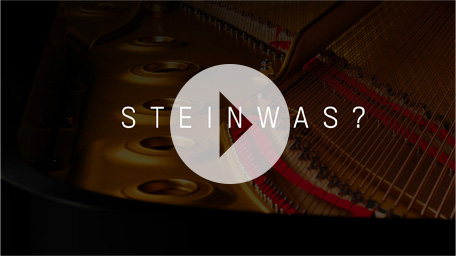
Steinwas?
Don't just take our word for it. Check out these customer stories from concert halls, Grammy nominees, music professors, concert pianists, and a world renown music university that debunk the Stein-was myth, and take time to hear the quality of sound yourself.
A Mechanical Comparison...
Is a car still a Mercedes if it needs repairs and if a specialized mechanic repairs it using parts from both Mercedes and their suppliers? Of course it is!

Our craftsmen's expert knowledge of piano restoration coupled with the materials used has allowed us to work with the Cleveland Institute of Music, late-night television hosts, Grammy-winning musicians, universities and colleges, and Academy Award-winning actors. Learn more about the restoration process in the next few sections.
"The Steinway Soundboard Is Impossible to Replicate"
Another thing Steinway & Sons claim is that only they have the skill, expertise, and machinery required to craft an authentic Steinway soundboard. They further state that their soundboards are "Impossible to replicate". While this is true for the vast majority of dealers and rebuilders, there are exceptions.
Expert Craftsmanship & Materials
Galo Torres worked as the soundboard Mastercraftsman at Steinway for 30 years before deciding to work for Lindeblad. He was trained by Steinway's best and has become one of the greatest Steinway soundboard craftsmen in the world.
For nearly 120 years Steinway crafted their soundboards by hand. Galo, our soundboard master-craftsman, adheres to those same original hand-crafted standards. Each one of our soundboards is carefully hand-cut, sculpted, and sanded to reveal its musical potential.
We use the same premier wood from the same supplier as Steinway New York and Steinway Hamburg. We select the choicest of Alaskan Sitka Spruce, the ideal wood for soundboards, because of its unparalleled stiffness-to-weight ratio. The wood is then cured to the precise moisture content specified by Steinway for each component of the soundboard. Learn more about our soundboards here.
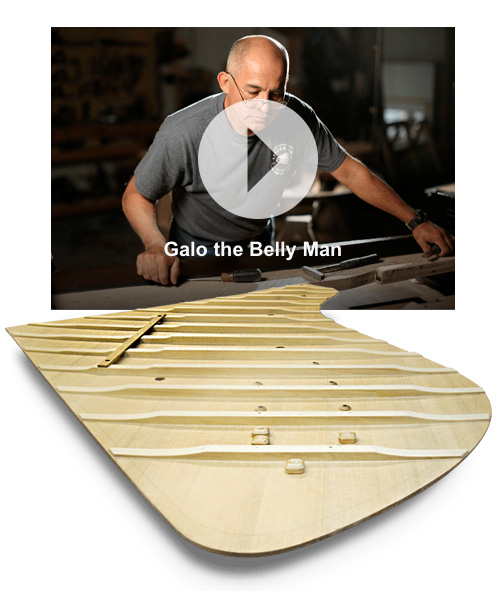
Soundboard Soundbite
It is important to note that while we can install a new Steinway Diaphragmatic Soundboard, only 25% of our Steinway restorations actually need a new soundboard. The majority of our restorations use the original Steinway soundboard and are simply repaired by Galo and his team and then refinished to return them to their original splendor.
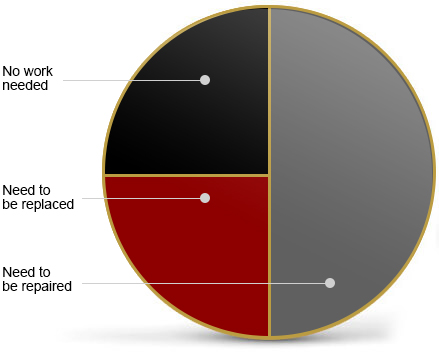
"Steinway's Pinblock Performs the Best"
What is a Pinblock?
The pinblock lies below the harp, and its sole purpose is to firmly grip the tuning pins in place. Over time the pins can loosen, which causes the piano to fall out of tune.
For 110 years, Steinway made their pinblock from five layers of hard rock maple, having the grain of each layer positioned 45 degrees to that of the next for maximum grip. Then in 1963, Steinway decided to use thinner pieces of maple and increased the number to seven layers.
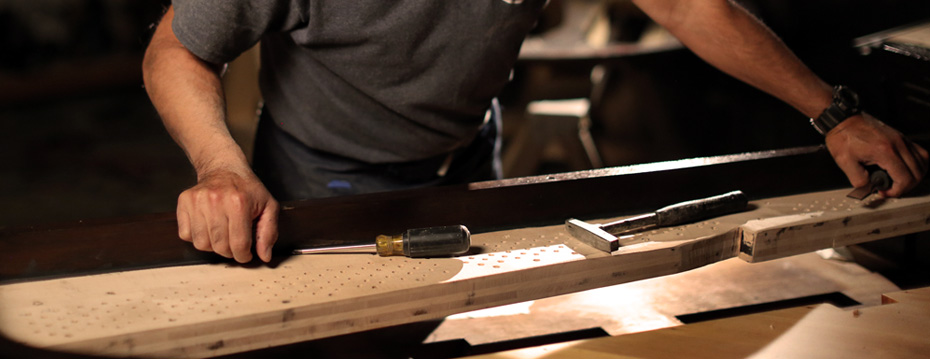
Historical Accuracy – Authentic Vintage Steinways
To maintain the historical accuracy of our Steinways, we use five-ply, quartersawn hard-rock maple pinblocks made to the same specifications as the original Steinways. We source these pinblocks from the world-renowned company Bolduc in Montréal, Canada.
Adams Romoleroux, a former Steinway employee and pinblock specialist who has joined the Lindeblad team, then makes a template from the piano's original pinblock to ensure the new pinblock is a custom fit for that piano.
There's No Secret Ingredient
A pinblock is wood, glue, and craftsmanship, combined together to create a durable and lasting hold. Lindeblad's pinblocks use the same wood and glue, crafted to vintage Steinway specifications, and installed by a former Steinway pinblock craftsman.
There is nothing secret or special about Steinway's Hexagrip pinblock. As long as the pinblock holds the tuning pins in place, it does not affect a Steinway's sound quality.
It's not the Steinway logo that makes a pinblock great. It's the craftsmanship and quality of wood that makes a pinblock great.
"Steinway's 'Accelerated Action' is Faster Than Their Original Action Design"
In the 1930s Steinway filed two patents for piano action modifications that were intended to provide a faster keystroke response. These two changes made up the Steinway term "Accelerated Action". The term can be somewhat deceptive since the design changes have nothing to do with the actual action parts that are used.
The first patent changed the shape of the balance rail (what the keys rest on), and the second patent changed where the keys were weighted. The phrase "Accelerated Action" is a marketing term used by Steinway to create a false sense of exclusivity.

Is It Actually Better?
Steinway claimed that the "accelerated action" improved key repetition speed, but they never backed their claim by publishing the results of their studies.
According to a former Steinway President, in the 1970s Steinway New York started tweaking their "accelerated" action design because of problems they were having, and removed it all together around 1983. The Steinway factory in Hamburg, Germany never used the accelerated action design in any of their pianos.
Since the patents expired around 70 years ago, no other piano manufacturers have adopted this method, not even Steinway Hamburg. Why not? It doesn't enhance performance and it isn't actually better. It's just a clever marketing term.
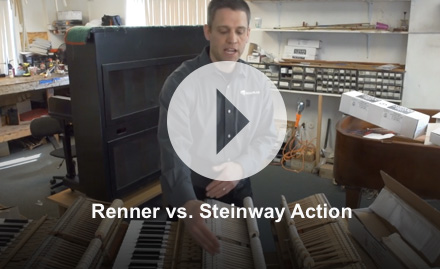
What Action Parts Does Lindeblad Use?
Lindeblad Piano is committed to providing world-class restoration for the finest Steinway pianos. This dedication to true Steinway restoration means that we use New York Steinway action parts or Renner action parts. Renner is the manufacturer of the action parts used in the Hamburg Steinways.
Our experienced action department is led by two master craftsmen, Eric Lindeblad and Peter Ribaudo, who have over 40 years of restoration experience each. They have worked on every type of Steinway and are industry leaders in action regulation and assembly.
Fun Fact
Steinway acquired Renner in July 2019. Check out Steinway's full announcement regarding the acquisition HERE.
"Buying a Steinway is an Investment"
New Steinway Grands are incredibly expensive and can range from $75,500 – $585,000 (as of 2021). To justify the considerable expense, Steinway salesmen claim1 that a well maintained Steinway piano is a "better investment than buying stock on Wall Street"1. Don't be fooled by this.
Steinway's argument is that since the price of new pianos rise every year, the price of older pianos should also "regularly increase in value". A quick Google search will reveal this isn't the case. The truth is that used Steinways depreciate in value similar to that of used cars. The price of new cars rises each year and yet the value of older cars often depreciate heavily after purchase.
Many people have bought into this "investment" narrative Steinway pushes, only to later find themselves out tens of thousands of dollars.
Don't Make the Same Mistake
An article from New York Post1 shares how "Angry buyers of Steinway pianos say they were duped by salespeople who told them the instruments would increase in value, though they actually plunge in price by 50 percent or more as soon as they leave the showroom floor…"1
The article continues on to describe one woman's shock upon learning the truth of Steinway's investment claims: "Kelly Kilrea made $68,000 in payments [on a new $78,000 Steinway] but when she could no longer afford them, she looked into selling the instrument, only to learn that she wouldn't get more than about $33,000 from a used-piano dealer, which is what she still owes Steinway."1
1 New York Post, Steinway Piano Customers Claim They Were Duped Into "Investment"
The Steinway Value
While pianos don't typically appreciate in value, it is worth noting that Steinways do hold their value significantly longer than any other piano brand. The biggest investment, however, is the benefit and personal enrichment that a world-class Steinway can bring. One that can be enjoyed and passed down from generation to generation.

A Steinway piano "is going to go down in value significantly right off the bat." 1
"Steinway Never Had a Golden Age"
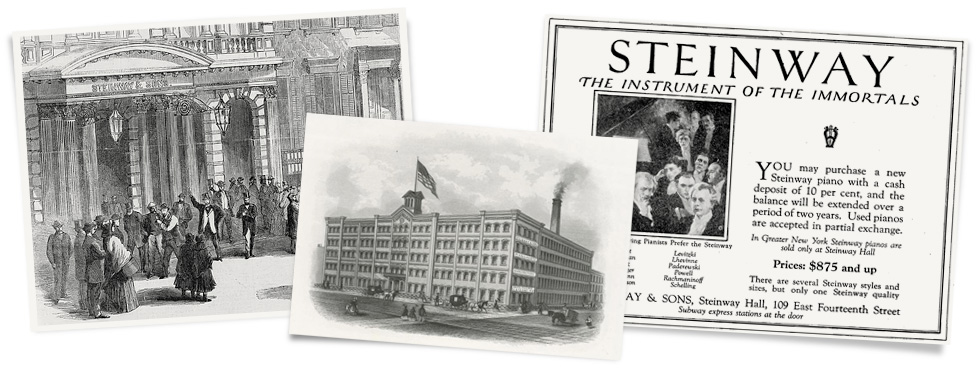
It is well-known that Steinway produced some of their best work from the 1900s to the 1940s. The original Steinway family was still heavily involved in production-the same cannot be said today, as the company is currently owned by a hedge fund billionaire. All manufacturing was done in-house, and all parts of the piano were crafted by hand.
It was, as some call it, the "Golden Age of Steinway."
Why Steinway Denies the Golden Age
Steinway understandably rejects the concept that certain Steinway vintages were made better than others. After all, how could they sell new pianos if this is the case? Simply put, Steinway denies the Golden Age concept because it would be harmful for the sale of new Steinway pianos.
"I have a much better opinion of the older Steinways. And I think this is in that category. They don't make them like they used to. The new pianos that you're buying now are nowhere near as good as they used to be"
The "40 Years Ago" Myth
Steinway argues that the Golden Age is always 40 years ago, no matter when in history. A little research reveals this simply isn't the case. From the 1960s up to the 1980s, Steinway action parts were crafted using problematic teflon bushings. This change occasionally caused a "clicking" in certain action models and wasn't well received. No one ever argues that the teflon-action era or the eras following it were Steinway's "Golden Age".
Fun Fact
Vladimir Horowitz2, one of the greatest concert pianists of all time, refused to own or perform on any newer Steinway models. Instead he insisted that his 1935 and later his 1943 Steinway concert grand accompany him for all performances no matter the cost.
2 Steinway & Sons, Famed Vladimir Horowitz Piano To Continue Its North American Tour
Working With
Lindeblad
The Lindeblad Secret –
How We Sell Premium Steinways for Half the Cost
Lindeblad provides Steinway restorations on par with Steinway, yet we offer our pianos at a far more competitive price compared to the cost of a new Steinway. How is this possible? We buy our Steinways at low rates, don't bear the large manufacturing cost of the harp and case, and don't include markups that Steinway dealers apply to their pianos.
The result? You end up with a world-class Steinway, uncompromised in quality and performance, with historically accurate parts installed by Steinway craftsmen, for half the price you would pay for a new one. For more information on parts and craftsmanship, please refer back to Chapter 3.
Explore our inventory of grand and upright pianos
View Our Steinway Inventory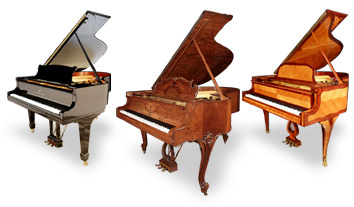

You Save with Our Buying Power
Being one of the largest piano dealers in the world gives us the abitlity to pick up the best quality, used Steinways at or below market value. Those savings get passed on to our customers giving them the flexbility to save money or invest back into their Steinway.
You Save When We Restore
With the harp and case already made, our customers don't incur the very significant costs of labor, materials, making the harp, complex rim bending machines, lumber yards, and the two years of overhead it can take for the wood to cure properly.
You're the Only One We Answer To
Lindeblad's pricing doesn't include the heavy markup that Steinway dealers have to apply to their pianos. Since we aren't owned by a large hedge fund (Paulson & Co.), we never have to compromise our customers' needs against board members or extensive executive staff.
"An hour before we played this piano at Lindeblad studios, we were playing a brand new, concert grand nine-foot Steinway piano in Paramus, New Jersey, at the Steinway studios. And I was worried that when we got down to Lindeblad's, we were going to say, oh, that new piano was so much better. But the reality was that all the pianists felt, like I did, that this piano had a lot more depth and was just actually far superior to the brand new piano."
Experience Lindeblad –
The Steinway Specialists
The Power of Experience
Since founding Lindeblad Piano in 1920, the Lindeblad family has spent over 100 years restoring pianos to their former glory and have accumulated four generations' worth of experience. Lindeblad's restoration team features three seasoned Steinway craftsmen with over 45 years of combined Steinway-factory experience. Our entire team of craftsmen have over 300 years of combined experience and are a major reason why Lindeblad has become a global leader in the art of Steinway restoration.
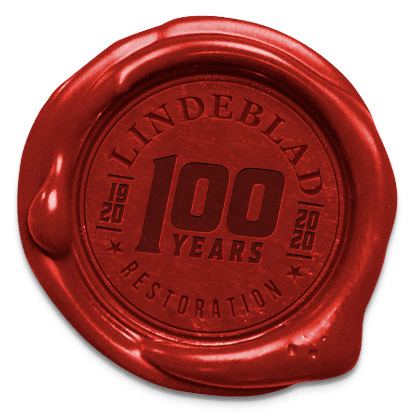
Seasoned
Steinway
Craftsman
Years of
Steinway-factory
Experience
of Pianos We
Sell or Restore
Are Steinways
Total
Craftspeople
Combined
Years of
Experience
Pianos Sold
or Restored
Lindeblad Restoration Tour
In addition, Lindeblad's scale and structure of operations maximizes our craftsmen's proficiency and expertise. Our 25,000 sq. ft. restoration center is organized so that along every step of the restoration process, a customer's piano is carefully attended to by craftsmen who specialize in each individual component. As a result, each specialist is a master of their craft, knowing the slight but essential differences between the Steinway years and models.
Your Own
Custom Steinway
One of the greatest advantages to choosing Lindeblad is the opportunity to customize a Steinway to your exact preferences. Our customers work personally with owner Todd Lindeblad to determine exactly what they are looking for in a Steinway piano.
No other Steinway restoration company offers the same level of in-depth customization as Lindeblad Piano. Don't make it a Steinway, make it your Steinway.
- Size of Piano
- Budget and Price Range
- Color (Wood Tone, Ebony, or White)
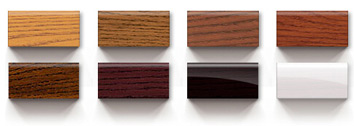
- Style (Traditional, Louis XV, Art Deco, Etc.)

- Finish (Satin or High-gloss)
- Action (NY Steinway Action or Renner Action)*
- Touch (From Heavy to Light)
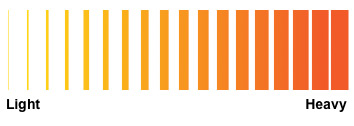
- Tone (From Mellow to Bright)
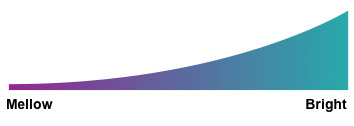
* Used in all Hamburg Steinways
Customizing Your Steinway
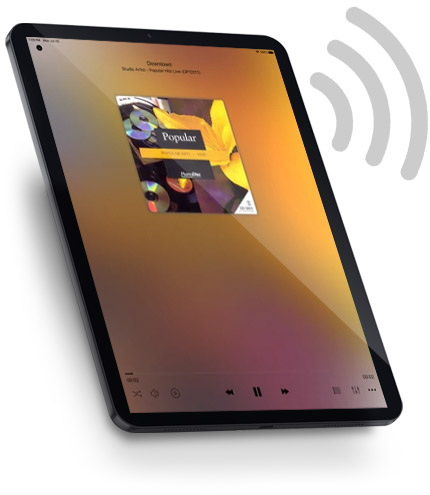
Install a Player System Into Any Steinway
Along with our customization features, we can also install a piano player system into any piano chosen by the customer. From classical to pop, have any song played by a professional at the snap of your fingers. Entertain for guests, relax after a stressful day, and appreciate real music being played in your own home.
Our player systems feature the option to record and playback your own music, as well as a "silent option" which allows you to listen to your piano via Bluetooth headphones. And while Steinway only installs players into their Model M, B & D pianos, we can install a player system into any piano of your choice.
Lindeblad Restored
Steinway Certificate
Our certificate is granted to customers who have had their pianos fully restored by Lindeblad Piano, and is signed by owners Paul and Todd Lindeblad. If an authentic Steinway restoration is scrutinised, ask the seller if it was restored by Lindeblad and if they have a certificate for proof.
If your piano has been fully restored by Lindeblad and you have not received a certificate, contact us to receive your official document. 888.587.4266

Customer Satisfaction
Guaranteed
We seek to provide the highest level of customer service, experience, and restoration quality at every step of your piano purchasing journey. Lindeblad Piano's number one priority is to make our customers feel valued and taken care of and we are available to take your call and answer questions 24/7. Some piano companies either don't provide a phone number or don't return your call or email in a timely manner. Not only are we incredibly responsive, but you will speak with either the owner or a member of our highly experienced team, professionals with intimate knowledge of pianos and the processes involved.
We are committed not simply to delivering a piano, but to giving complete satisfaction. For customers who can't travel to our showroom, we use a range of tools to ensure that the piano you choose ends up exactly as you desire.


We conduct an extensive interview with every client to learn the tone and feel that you prefer. Once you are satisfied, we begin the restoration and share updates on the piano's progress until it's complete.

We have strong relationships with reputable and accomplished concert pianists who can play pianos on our clients' behalf.

We offer a 30-Day Money Back Guarantee. If we deliver a piano that a client doesn't like, we provide a 100% refund of the purchase price and bring the piano back to our facility.

We provide a high-quality audio and video recording of a client's selected piano before shipping upon request.
"Paul and Todd aren't in the business of just selling pianos. They're in the business of fulfilling your dreams and making sure that the piano you get is the one that you've always wanted, and that's exactly what they've done."
Trusted by Thousands
of Steinway Owners
Top industry professionals from all over the world trust Lindeblad when purchasing and restoring a Steinway.

- Academy Award Winning Actors
- Institutes of Music
- Concert Pianists
- Former Vice Presidents
- Grammy Award Winners
- Late-Night TV Hosts
- Las Vegas Casinos
- Probowl Football Players
- Universities & Colleges
- Steinway Artists
- Grammy Nominees
- Opera Houses
"My Steinway D was a complete rebuild, and it's just incredible. I've got to find some more superlatives: "incredible, great, amazing!" The look, the finish is incredible."
The Lindeblad
Advantage
Our service has a strong international reach. We've delivered pianos to 48 states, 10 countries, and average over 500,000 moving miles a year! Throughout the entire restoration process, we treat any piano with the utmost care, and every piano's move is fully insured.
Our services include:


Nationwide Free Shipping
Located 3,000 miles away? No worries. We ship over 600 pianos nationwide every year, completely free of charge.

National Network of Piano Technicians
We work with dedicated piano technicians nationwide to provide a final tuning and guarantee that your piano plays exactly to your preferences.

5 to 20-Year Warranty
We guarantee the quality of our craftsmanship for up to 20 years. Call us with any questions, concerns, or problems and we'll cover it.

Lifetime Trade-In Policy
Along with our warranty comes a lifetime guaranteed trade-in policy to ensure customer satisfaction.

30-Day 100% Money-Back Guarantee
If you don't like the piano you purchased, we'll provide you with a 100% refund. It's that simple.

Start Your Personal Steinway Journey Today!
Interested in a Steinway and want to talk over your options with a friendly expert?
Give us a call now to discover how easy it can be to own the piano of your dreams!
888.587.4266